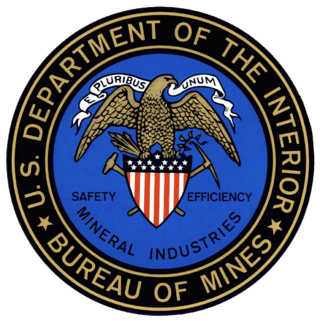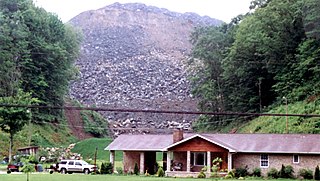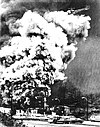Coal dust is a fine-powdered form of coal which is created by the crushing, grinding, or pulverization of coal rock. Because of the brittle nature of coal, coal dust can be created by mining, transporting, or mechanically handling it.

The Occupational Safety and Health Act of 1970 is a US labor law governing the federal law of occupational health and safety in the private sector and federal government in the United States. It was enacted by Congress in 1970 and was signed by President Richard Nixon on December 29, 1970. Its main goal is to ensure that employers provide employees with an environment free from recognized hazards, such as exposure to toxic chemicals, excessive noise levels, mechanical dangers, heat or cold stress, or unsanitary conditions. The Act created the Occupational Safety and Health Administration (OSHA) and the National Institute for Occupational Safety and Health (NIOSH).

The National Institute for Occupational Safety and Health is the United States federal agency responsible for conducting research and making recommendations for the prevention of work-related injury and illness. NIOSH is part of the Centers for Disease Control and Prevention (CDC) within the U.S. Department of Health and Human Services. Despite its name, it is not part of either the National Institutes of Health nor OSHA. Its current director is John Howard.

For most of the 20th century, the United States Bureau of Mines (USBM) was the primary United States government agency conducting scientific research and disseminating information on the extraction, processing, use, and conservation of mineral resources. The Bureau was abolished in 1996.

The Mine Safety and Health Administration (MSHA) is a large agency of the United States Department of Labor which administers the provisions of the Federal Mine Safety and Health Act of 1977 to enforce compliance with mandatory safety and health standards as a means to eliminate fatal accidents, to reduce the frequency and severity of nonfatal accidents, to minimize health hazards, and to promote improved safety and health conditions in the nation's mines. MSHA carries out the mandates of the Mine Act at all mining and mineral processing operations in the United States, regardless of size, number of employees, commodity mined, or method of extraction. David Zatezalo was sworn in as Assistant Secretary of Labor for Mine Safety and Health, and head of MSHA, on November 30, 2017. He served until January 20, 2021. Jeannette Galanais served as Acting Assistant Secretary by President Joe Biden on February 1, 2021 until Christopher Williamson took office on April 11, 2022.

Black lung disease (BLD), also known as coal-mine dust lung disease, or simply black lung, is an occupational type of pneumoconiosis caused by long-term inhalation and deposition of coal dust in the lungs and the consequent lung tissue's reaction to its presence. It is common in coal miners and others who work with coal. It is similar to both silicosis from inhaling silica dust and asbestosis from inhaling asbestos dust. Inhaled coal dust progressively builds up in the lungs and leads to inflammation, fibrosis, and in worse cases, necrosis.

The Federal Coal Mine Health and Safety Act of 1969, U.S. Public Law 91-173, generally referred to as the Coal Act, was passed by the 91st United States Congressional session and enacted into law by the 37th President of the United States Richard Nixon on December 30, 1969.

The Monongah mining disaster was a coal mine explosion on December 6, 1907, at Fairmont Coal Company's Nos. 6 and 8 mines in Monongah, West Virginia, which killed 362 miners. It has been described as "the worst mining disaster in American history" and was one of the contributing events that led to the creation of the United States Bureau of Mines.

An abandoned mine refers to a former mining or quarrying operation that is no longer in use and has no responsible entity to finance the cost of remediation and/or restoration of the mine feature or site. Such mines are typically left unattended and may pose safety hazards or cause environmental damage without proper maintenance. The term incorporates all types of old mines, including underground shaft mines and drift mines, and surface mines, including quarries and placer mining. Typically, the cost of addressing the mine's hazards is borne by the public/taxpayers/the government.

Experimental Mine, U.S. Bureau of Mines is a landmark located in the Pittsburgh suburb of Bruceton, Pennsylvania. In 1910, the newly created U.S. Bureau of Mines leased a 38-acre tract of land from the Pittsburgh Coal Company and opened the Experimental Mine.
An occupational fatality is a death that occurs while a person is at work or performing work related tasks. Occupational fatalities are also commonly called "occupational deaths" or "work-related deaths/fatalities" and can occur in any industry or occupation.
Mining in the United States has been active since the beginning of colonial times, but became a major industry in the 19th century with a number of new mineral discoveries causing a series of mining rushes. In 2015, the value of coal, metals, and industrial minerals mined in the United States was US$109.6 billion. 158,000 workers were directly employed by the mining industry.

Occupational safety and health (OSH) or occupational health and safety (OHS) is a multidisciplinary field concerned with the safety, health, and welfare of people at work. OSH is related to the fields of occupational medicine and occupational hygiene and aligns with workplace health promotion initiatives. OSH also protects all the general public who may be affected by the occupational environment.
The Office of Mine Safety and Health Research (OMSHR) was a division within the United States' National Institute for Occupational Safety and Health (NIOSH) devoted towards the elimination of mining fatalities, injuries, and illnesses through research and prevention.

Mine safety is a broad term referring to the practice of controlling and managing a wide range of hazards associated with the life cycle of mining-related activities. Mine safety practice involves the implementation of recognised hazard controls and/or reduction of risks associated with mining activities to legally, socially and morally acceptable levels. While the fundamental principle of mine safety is to remove health and safety risks to mine workers, mining safety practice may also focus on the reduction of risks to plant (machinery) together with the structure and orebody of the mine.

The Federal Coal Mine Safety Act of 1952 is a U.S. law authorizing the federal government to conduct annual inspections of underground coal mines with more than 15 workers, and gave the United States Bureau of Mines the authority to shut down a mine in cases of "imminent danger." The Act authorized the assessment of civil penalties against mine operators for failing to comply with an order to shut down or for refusing to give inspectors access to mine property. The law did not authorize monetary penalties for noncompliance with the safety provisions. In 1966, Congress extended coverage to all underground coal mines.

Joseph Austin Holmes was a geologist and occupational safety and health pioneer, best known as the first director of the U.S. Bureau of Mines. He is the namesake of the Joseph A. Holmes Safety Association created in 1916.

Environmental justice and coal mining in Appalachia is the study of environmental justice – the interdisciplinary body of social science literature studying theories of the environment and justice; environmental laws, policies, and their implementations and enforcement; development and sustainability; and political ecology – in relation to coal mining in Appalachia.
J. Davitt McAteer is an American lawyer, author, and activist from Fairmont, West Virginia. McAteer was appointed to the position of assistant secretary for the Mine Safety and Health Administration from 1993 to 2000 under President Bill Clinton. Throughout his career, McAteer has been an advocate for safe working conditions for miners, particularly in the coal industry. After the Upper Big Branch Mine disaster of 2010, where an explosion caused by negligence led to the death of 29 miners, McAteer Served on Governor Earl Ray Tomblin's independent investigation panel to determine the cause of the explosion. McAteer is the author of "Monongah: The Tragic Story of the 1907 Monongah Mine Disaster".

The Division of Industrial Hygiene was a division of the U.S. Public Health Service (PHS) with responsibility for occupational safety and health programs. It existed from 1914 until 1971, when it became the National Institute for Occupational Safety and Health (NIOSH). It had several names during its existence, most notably the Office of Industrial Hygiene and Sanitation in its earlier years and the Division of Occupational Health during its later years.














